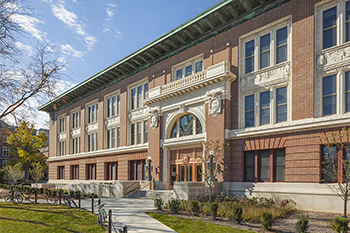USGBC Names Top 10 LEED States
 WASHINGTON — To recognize regions and states committed to producing high performing green buildings, the USGBC has released it’s annual ranking of the top 10 LEED states in the U.S. States were rated by information gathered in the 2010 U.S. Census and projects that were certified in 2013.
WASHINGTON — To recognize regions and states committed to producing high performing green buildings, the USGBC has released it’s annual ranking of the top 10 LEED states in the U.S. States were rated by information gathered in the 2010 U.S. Census and projects that were certified in 2013.
“The list of the top 10 States for LEED is a continuing indicator of the widespread recognition of our national imperative to create healthier, high performing buildings that are better for the environment as well as the people who use them every day,” said Rick Fedrizzi, president, CEO and founding chair of USGBC, in a statement. “As the economy recovers, green buildings continue to provide for jobs at every professional level and skill set from carpenters to architects. I congratulate everyone in these states whose contributions to resources saved, toxins eliminated, greenhouse gases avoided and human health enhanced help guarantee a prosperous future for our planet and the people who call it home.”
The USGBC found that the data collected demonstrates a growing trend in achieving LEED by renovating existing buildings. Approximately 48 percent of all square footage in 2013 was certified under LEED for Building Operations and Maintenance, while 43 percent was certified under LEED for Building Design and Construction, according to the USGBC.
Topping off the list of green building states is Illinois with 171 projects gaining LEED certification in 2013, representing 2.29 square feet of LEED space per resident. The state was ranked fifth in 2013, which demonstrates the state’s steady and growing commitment to sustainable buildings.
“Both the public and private sectors in Illinois recognize that long-term investments in 21st century infrastructure should be done in ways that reduce energy consumption and protect the environment,” said Illinois Gov. Pat Quinn, in a statement. “Illinois is proud to be the nation’s green buildings leader, and we are proof that a smaller environmental footprint can help us step toward energy independence.”
Some notable LEED projects certified in Illinois in 2013 include the LEED Platinum Lincoln Hall at the University of Illinois at Urbana-Champaign, The Illinois Holocaust Museum and Education Center, which achieved LEED Gold, and the LEED Platinum Choices Mental Health Facility.
“In the face of the extraordinary global challenge of climate change, our national imperative to create resource-efficient and cost-effective green buildings has never been greater,” Fedrizzi said. “Illinois has a strong base of dedicated individuals who are using LEED to transform its built infrastructure into high-performing spaces that promote the health of our planet and the people who use these buildings each and every day.”
The final rankings are as follows:
1. Illinois: 171 projects and 29.4 million square feet certified in 2013, representing 2.29 per-capita square footage.
2. Maryland: 119 projects and 12.7 million square feet certified, representing 2.2 per-capita square footage.
3. Virginia: 160 projects and 16.8 million square feet certified, representing 2.1 per-capita square footage.
4. Massachusetts: 101 projects and 13.6 million square feet certified, representing 2.09 per-capita square footage.
5. New York (tied): 259 projects and 37.8 million square feet certified, representing 1.95 per-capita square footage.
5. California (tied): 595 projects and 72.7 million square feet certified, representing 1.95 per-capita square footage.
6. Oregon: 47 projects and 6.99 million square feet certified, representing 1.83 per-capita square footage.
7. North Carolina: 133 projects and 17.2 million square feet certified, representing 1.8 per-capita square footage.
8. Colorado: 124 projects and 8.9 million square feet certified, representing 1.77 per-capita square footage.
9. Hawaii: 17 projects and 2.3 million square feet certified, representing 1.71 per-capita square footage.
10. Minnesota: 51 projects and 8.2 million square feet certified, representing 1.55 per-capita square footage.
